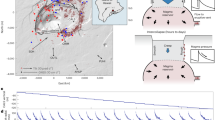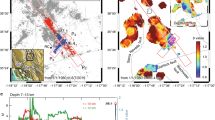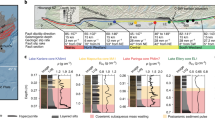Abstract
Although dynamic stress changes associated with the passage of seismic waves are thought to trigger earthquakes at great distances, more than 60 per cent of all aftershocks appear to be triggered by static stress changes within two rupture lengths of a mainshock1,2,3,4,5. The observed distribution of aftershocks may thus be used to infer details of mainshock rupture geometry6. Aftershocks following large mid-continental earthquakes, where background stressing rates are low, are known to persist for centuries7,8, and models based on rate-and-state friction laws provide theoretical support for this inference9. Most past studies of the New Madrid earthquake sequence have indeed assumed ongoing microseismicity to be a continuing aftershock sequence10,11,12. Here we use instrumentally recorded aftershock locations and models of elastic stress change to develop a kinematically consistent rupture scenario for three of the four largest earthquakes of the 1811–1812 New Madrid sequence. Our results suggest that these three events occurred on two contiguous faults, producing lobes of increased stress near fault intersections and end points, in areas where present-day microearthquakes have been hitherto interpreted as evidence of primary mainshock rupture. We infer that the remaining New Madrid mainshock may have occurred more than 200 km north of this region in the Wabash Valley of southern Indiana and Illinois—an area that contains abundant modern microseismicity, and where substantial liquefaction was documented by historic accounts. Our results suggest that future large mid-plate earthquake sequences may extend over a much broader region than previously suspected.
This is a preview of subscription content, access via your institution
Access options
Subscribe to this journal
Receive 51 print issues and online access
$199.00 per year
only $3.90 per issue
Buy this article
- Purchase on Springer Link
- Instant access to full article PDF
Prices may be subject to local taxes which are calculated during checkout




Similar content being viewed by others
References
Johnston, A. C. & Schweig, E. S. The enigma of the New Madrid earthquakes of 1811–1812. Annu. Rev. Earth Planet. Sci. Lett. 24, 339–384 (1996)
Kilb, D., Gomberg, J. & Bodin, P. Triggering of earthquake aftershocks by dynamic stresses. Nature 408, 570–574 (2000)
Das, S. & Scholz, C. H. Off-fault aftershock clusters caused by shear-stress increase. Bull. Seismol. Soc. Am. 71, 1669–1675 (1981)
Reasenberg, P. A. & Jones, L. M. Earthquake hazard after a mainshock in California. Science 243, 1173–1176 (1989)
Toda, S., Stein, R. S., Reasenberg, P. A., Dieterich, J. H. & Yoshida, A. Stress transferred from the 1995 Mw = 6.9 Kobe Japan, shock: Effect on aftershocks and future earthquake probabilities. J. Geophys. Res. 103, 24,543–24,565 (1998)
Seeber, L. & Armbruster, J. G. Earthquakes as beacons of stress change. Nature 407, 69–72 (2000)
Ebel, J., Bonjer, E. & Oncescu, M. Paleoseismicity: Seismicity evidence for past large earthquakes. Seismol. Res. Lett. 71, 283–294 (2000)
Gan, W. & Prescott, W. H. Crustal deformation rates in central and eastern U.S. inferred from GPS. Geophys. Res. Lett. 28, 3733–3736 (2001)
Dieterich, J. A constitutive law for rate of earthquake production and its application to earthquake clustering. J. Geophys. Res. 99, 2601–2618 (1994)
Nuttli, O. W. The Mississippi Valley earthquakes of 1811 and 1812: Intensities, ground motion, and magnitudes. Bull. Seismol. Soc. Am. 63, 227–248 (1973)
Mueller, K. & Pujol, J. Three-dimensional geometry of the Reelfoot blind thrust: implications for moment release and earthquake magnitude in the New Madrid seismic zone. Bull. Seismol. Soc. Am. 91, 1563–1573 (2001)
Johnston, A. C. Seismic moment assessment of earthquakes in stable continental regions III, New Madrid 1811–1812, Charleston 1886, and Lisbon 1755. Geophys. J. Int. 126, 314–344 (1996)
Guccione, M. J., VanArsdale, R. B. & Hehr, L. H. Origin and age of the Manila high and associated Big Lake “sunklands” in the New Madrid seismic zone, northeastern Arkansas. Geol. Soc. Am. Bull. 112, 579–590 (2000)
Hough, S. E., Armbruster, J. G., Seeber, L. & Hough, J. F. On the modified Mercalli intensities and magnitudes of the 1811–1812 New Madrid, central United States earthquakes. J. Geophys. Res. 105, 23839–23864 (2000)
Baldwin, J. N., Barron, A. D., Kelson, K. I., Harris, J. B. & Cashman, S. Preliminary paleoseismic and geophysical investigation of the north Farrenburg lineament: Primary tectonic deformation associated with the New Madrid North fault? Seismol. Res. Lett. 73, 393–413 (2002)
Odum, J. K., Stephenson, W. J., Shedlock, K. M. & Pratt, T. L. Near-surface structural model for deformation associated with the February 7, 1812, New Madrid, Missouri, earthquake. Geol. Soc. Am. Bull. 110, 149–162 (1998)
Van Arsdale, R. B., Kelson, K. I. & Lumsden, C. H. Northern extension of the Tennessee Reelfoot scarp into Kentucky and Missouri. Seismol. Res. Lett 65, 57–62 (1995)
Kelson, K. I., Simpson, G. D., VanArsdale, R. B., Haraden, C. C. & Lettis, W. R. Multiple late Holocene earthquakes along the Reelfoot fault, central New Madrid seismic zone. J. Geophys. Res. 101, 6151–6170 (1992)
Guccione, M. J. et al. Stream response to repeated coseismic folding, Tiptonville Dome, western Tennessee. Geomorph 43, 313–349 (2002)
Gomberg, J. & Ellis, M. Topography and tectonics of the central New Madrid seismic zone: Results of numerical experiments using a three-dimensional boundary element program. J. Geophys. Res. 99, 20299–20310 (1994)
Bakun, W. H. & Wentworth, C. M. Estimating earthquake location and magnitude from seismic intensity data. Bull. Seismol. Soc. Am. 87, 1502–1521 (1997)
Hough, S. E. & Martin, S. Magnitude estimates of two large aftershocks of the 16 December 1811 New Madrid earthquake. Bull. Seismol. Soc. Am. 92, 3259–3268 (2002)
Berry, D. L. The Illinois earthquake of 1811 and 1812. Illinois State Hist. Soc. Trans. 12, 74–78 (1908)
Stauder, W. & Nuttli, O. W. Seismic studies—south-central Illinois earthquake of November 9, 1968. Bull. Seismol. Soc. Am. 60, 973–981 (1970)
Hough, S. E. Triggered earthquakes and the 1811–1812 New Madrid, central U.S. earthquake sequence. Bull. Seismol. Soc. Am. 91, 1574–1581 (2001)
Tuttle, M. P. The use of liquefaction features in paleoseismology: Lessons learned in the New Madrid seismic zone, central United States. J. Seismol. 5, 361–380 (2001)
Pavlis, G. L., Rudman, A. J., Pope, B. P., Hamburger, M. W. & Bear, G. W. Seismicity of the Wabash Valley seismic zone based on a temporary seismic array experiment. Seismol. Res. Lett. 73, 751–761 (2002)
Acknowledgements
Support for this work was provided to R.B. by the National Science Foundation.
Author information
Authors and Affiliations
Corresponding author
Ethics declarations
Competing interests
The authors declare that they have no competing financial interests.
Rights and permissions
About this article
Cite this article
Mueller, K., Hough, S. & Bilham, R. Analysing the 1811–1812 New Madrid earthquakes with recent instrumentally recorded aftershocks. Nature 429, 284–288 (2004). https://doi.org/10.1038/nature02557
Received:
Accepted:
Issue Date:
DOI: https://doi.org/10.1038/nature02557
This article is cited by
-
Strong historical earthquakes and their relationships with the Tan-Lu fault system and modern seismicity in eastern China
Natural Hazards (2023)
-
An updated stress map of the continental United States reveals heterogeneous intraplate stress
Nature Geoscience (2018)
-
Hydrologically-driven crustal stresses and seismicity in the New Madrid Seismic Zone
Nature Communications (2017)
-
Considering large earthquake clustering in seismic risk analysis
Natural Hazards (2016)
-
Triggering of New Madrid seismicity by late-Pleistocene erosion
Nature (2010)
Comments
By submitting a comment you agree to abide by our Terms and Community Guidelines. If you find something abusive or that does not comply with our terms or guidelines please flag it as inappropriate.



